Blobokapi
Posted by: Loren Coleman on September 17th, 2008
These remarkable photographs of this elusive rainforest mammal tell us that sometimes trailcams do work.
What does a living fossil look like via a trailcam, initially? First, therefore, a blobokapi must be shared.
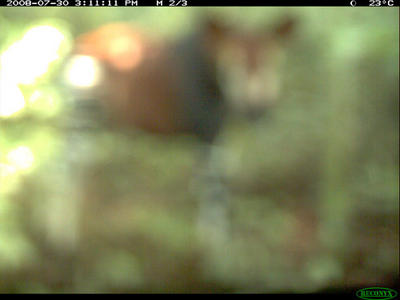
These are the first photographs of the elusive okapi in the wild by camera trap. They were taken by the Zoological Society of London’s team (in conjunction with the Congolese Institute for Nature Conservation) in the Watalinga forest, north of the Virunga National Park in the eastern portion of the Democratic Republic of Congo.

The last official sighting in the area was nearly 50 years ago. But a survey in 2006 by conservation group WWF found their tracks on the west bank of the Semliki River, in the park’s northern sector. Now these new pictures confirm that the okapi is actually there.
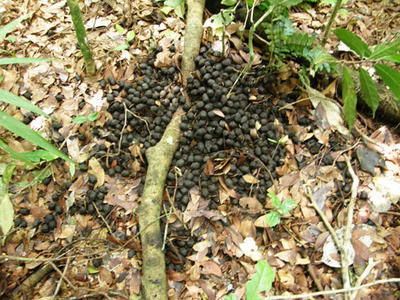
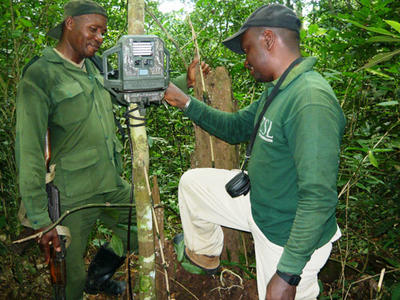
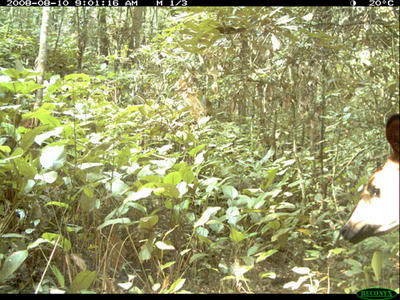
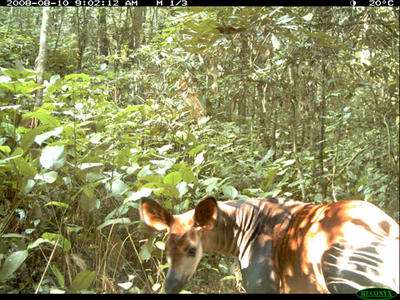
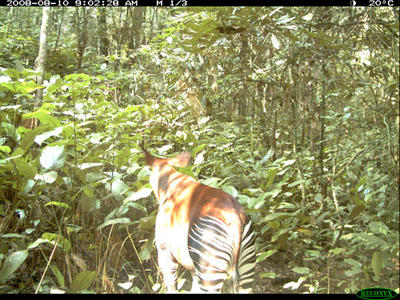
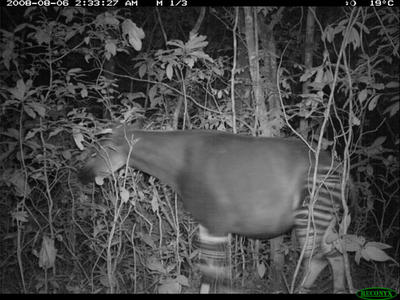
About Loren Coleman
Loren Coleman is one of the world’s leading cryptozoologists, some say “the” leading living cryptozoologist. Certainly, he is acknowledged as the current living American researcher and writer who has most popularized cryptozoology in the late 20th and early 21st centuries.
Starting his fieldwork and investigations in 1960, after traveling and trekking extensively in pursuit of cryptozoological mysteries, Coleman began writing to share his experiences in 1969. An honorary member of Ivan T. Sanderson’s Society for the Investigation of the Unexplained in the 1970s, Coleman has been bestowed with similar honorary memberships of the North Idaho College Cryptozoology Club in 1983, and in subsequent years, that of the British Columbia Scientific Cryptozoology Club, CryptoSafari International, and other international organizations. He was also a Life Member and Benefactor of the International Society of Cryptozoology (now-defunct).
Loren Coleman’s daily blog, as a member of the Cryptomundo Team, served as an ongoing avenue of communication for the ever-growing body of cryptozoo news from 2005 through 2013. He returned as an infrequent contributor beginning Halloween week of 2015.
Coleman is the founder in 2003, and current director of the International Cryptozoology Museum in Portland, Maine.










It’s obviously just a mangy sasquatch.
50 years, an animal that size. There’s hope for the thylacine yet, even after 70 I say.
Funny you should say that youcantryreachingme.
I looked at the first photo and was struck at how it could be claimed to be a Thylacine, or TC or any number of “unexplained” or “unexpected” beasts. Just goes to show how utterly useless such photos are in proving anything other than “something was there”.
Hi david – yes, at a glance the thought of a thylacine came to my mind too. It looks like a blurred version of the animated machine used for the beer ads. All the right colours is what did the trick I think.
Something else seems certain – an okapi doesn’t much look like a zebra, although I thought they were the nearest relatives. Perhaps “nearest relative” does not equate to “another species of”.
An okapi’s nearest “relative” is not a zebra, which is a horse,
But it’s a giraffe, in the family Giraffidae, of course.
It is one of the worst reflections on cryptozoology that every single blobtid gets Internet play.
Trailcams work. It’s just that they aren’t perfect, and one must resist the urge to just go public with a sasquatch that is, see! Right there! Right …I know, it looks like leaves, but if you go up to that thing that looks like a trunk…
Post a shot when there is a clearly identifiable animal in it.
Pretty please…?
I think the okapi wins as being one of the cutest cryptids ever. Lookit those big doe eyes! *melts*
Thanks for sharing these, they’re awesome pictures!
Good show. Hope there’s at least a sizable population.
And it’s good that the trailcams came up with something good this time.
Nice story, Loren…
I think that it is encouraging to see such photographs considering the digital trailcam is a fairly recent invention. It gives me hope that with the number of people using trailcams now, we should look forward to many more photos of rare and hidden animals in the years to come. I’d like to see someone come up with a cheap underwater version of the trailcam. That would be cool!
What an enchanting creature!
Trailcams do work…..but only if the animal exists. Don’t expect any genuine Bigfoot trailcam photos…..ever.
This animal is absolutely beautiful!
Cryptoraptor, I understand your skepticism. Indeed we should all be skeptics, until solid proof of any animal is provided. Most scientists were skeptical of the Okapi before it was ‘discovered’ by western scientists although known to local people. However, it is a fact that there is more evidence available for a large primate in North America than any other well known cyptids such as Nessie, Mokele Mbembe, even the Yeti of the Himalayas (i.e.
i)footprint casts, bell curve distribution of foot sizes point to a real population of animals
ii)many thousands of credible eye witness accounts
iii)the concentration of eye witness accounts in the three states of Washington, Oregon, California and province of British Columbia, points to a real phenomenon, not just the figment of people’s imaginations
iv)unidentified animal calling sounds recorded mostly in these same areas of Pacific NW.
v)film and photographic evidence
vi)other physical evidence such as hair samples, skookum cast, nests
All of these when taken together, strongly point to the existance of a real animal. With any luck, who knows we could get some real good photos from a trailcam. Photographs aren’t enough evidence on their own, but they can be part of the overall jigsaw.
Cryptoraptor says: “Trailcams do work…..but only is [sic] the animal exists. Don’t expect any genuine Bigfoot trailcam photos…..ever.”
Any presumption about the nonexistence of any cryptid is just that: a presumption, backed by not a shred of evidence. Letting alone that one cannot prove the nonexistence of something, all of the evidence seems to indicate – as fmurphy1970 points out – that at least one cryptid, the one referred to above, exists. And there is a lot of it, in fact much more than we have had for any other species prior to its scientific confirmation.
That says nothing about when we can expect a trailcam photo. But to presume we’ll never get one because the animal doesn’t exist is, well, real science never makes such a statement. And if you ever hear a scientist making such a statement, that scientist has forsaken his science, and must be treated as a layman spouting off. (Unfortunately for science, a perfect discipline, it is practiced by people, who are imperfect.)
Let’s just note: the okapi was once the sasquatch.
Cryptoraptor responds:
September 17th, 2008 at 10:37 pm
Trailcams do work…..but only if the animal exists. Don’t expect any genuine Bigfoot trailcam photos…..ever
Just because you haven’t seen any,
” genuine Bigfoot trailcam photos ” doesn’t mean they don’t exist. It just means that you personally haven’t seen any.
Okapi really are as beautiful as they look in this photos. We have several in the St Louis Zoo and their strange coloration has always fascinated me. It is very interesting that their nearest relative is the giraffe. It would be very interesting to know what their common ancestor looked like and why they are so different.
Okapi have not only been photographed, they are in zoos. It is illogical to believe a population of eight foot tall man-apes in the US have eluded capture for the past 50 years much less eluded legitimate and definitive photographic or skeletal evidence. Phony looking plaster foot casts and scat evidence have not been definitive.
How many decades of no clear definitive photographic evidence of a Bigfoot would convince true believers of it’s non-existance? Remember, practically everyone these days has either a camera, video camera, or cellphone that has both. Wouldn’t it be logical to believe that one clear definitive photo would have been taken by now. One could say that there’s a 30 foot tall striped bear-like creature out there and that lack of clear evidence doesn’t mean that IT doesn’t exist either.
Finding new species, species believed to be extinct, etc.. is interesting. Even Bigfoot is interesting but will another 50 years of no bones, body, or definitive photographs convince diehards to the contrary? By definitive photographic evidence I mean a clear photo, universally agreed to be genuine, like the many clear photographs of chimps or gorillas that have been available for many decades and that you can find in books or on the internet.
cryptoraptor says:
“It is illogical to believe a population of eight foot tall man-apes in the US have eluded capture for the past 50 years much less eluded legitimate and definitive photographic or skeletal evidence. Phony looking plaster foot casts and scat evidence have not been definitive.”
Actually it’s the above argument that’s illogical. But we’ve spent so much time detailing exactly why (just enter sasquatch into the search here and look up DWA) that I want to keep this thread on the okapi and other existing species. (Oh, while we are on illogic: if the sasquatch exists, it’s an existing species. It’s not nonexistent because scientists think it is.)
But I do need to address this (sigh): “One could say that there’s a 30 foot tall striped bear-like creature out there and that lack of clear evidence doesn’t mean that IT doesn’t exist either.”
That simply shows ignorance of the evidence – an inexcusable sin if coupled with an arrogant presumption. Show me the database, with all the sightings of this stripey bear, all the tracks, all the scats, all the blood and hair samples. Show me how all that evidence behaves just the way a biologist would expect biodata to behave. EVERY KIND OF EVIDENCE we have for existing species – including a MOVIE, ferpetesake – we have for the sasquatch. Every kind of evidence, that is, other than the scientific followup that is essential to secure proof. It’s the illogical refusal to accept the evidence as worthy of further review that is the problem here, because more people are seeing these animals than are seeing species (like the okapi) that we know about.
We have all that data about known species – as well as specimens in zoos – because professionals, exactingly trained for just this work, assiduously PURSUE them, to photograph them, track them down, and bring them back alive (or dead). They take on the huge personal and professional risks, and difficulties absolutely incomprehenisble for the layman, for one reason. They know they are going to get something, at some point, or at least that there is something to get out there, because someone else did the hard (harder) work needed to secure the proof. How many are doing such work for the sasquatch and the yeti? (Hint: the number is one fewer than me.) No one had ANYTHING for the okapi, or the chimp, or the gorilla, or any other animal, until the proof was in – which only happened when the evidence reached such a crescendo that a well-funded search for proof finally happened. We passed that point, for the sasquatch, 40 years ago. What happened? Squat. An illogical refusal to be comfortable with the idea of an upright ape is, in my humble, the operative illogic here. If the sas exists – and the evidence says yes it does – it should have been confirmed, four decades ago. But scientists refused to believe – or even to credit as worth another look – what they saw in the Patterson film.
(I tried to keep it on existing species. Sigh.)
If you disagree with anything I have said so far: you need to read up, because you are just wrong.
I don’t mind an opinion. But you better back it up. You are talking to a SKEPTIC here. I don’t buy your presumption about the sasquatch. Because you don’t back it up. Nothing in that comfortable presumption that it’s “illogical” not to have it in hand by now washes; it’s all unfounded assumption, backed by no evidence, which is a hanging offense in any scientific discussion. Only a tiny fragment of the track evidence – just that alone – has been debunked as fake. Less than a small fraction of half a percent would be an overstatement. In other words, for all intents and purposes, all the track evidence stands, utterly unassessed by the scientific community. And that’s JUST the tracks.
If you are going to drag the sasquatch into this discussion, take a tip from Dr. DWA: know what you’re talking about.
Or read up.
The okapi was once the sasquatch. So was the chimpanzee.
I should clarify a statement I made up there.
I asserted (correctly) that no one is searching for the sasquatch and the yeti. I am correct, when one is talking about degreed professionals, accustomed to very long hours with very little return as they wait for the big score, with a big head start in accumulated data on the species, WORKING FULL TIME.
THAT is what is required to get camera trap shots like the ones you see above.
Everybody knows how much I love the TBRC. (I root for the BFRO to rise to their standard of research, although its database is still the gold standard for the sasquatch continent-wide.) But they would be the first people to tell you that they have a very slim knowledge base to work from and that they are in no way full time.
THAT is the problem. The guys that got the okapi shots above are full-time okapi specialists (or working directly with them).
And don’t come back with how easy it is to get cam-trap shots of deer, black bear and coyote. These are animals that have become quite acclimated to humans, and are (probably) far more abundant than the sasquatch is, if it exists. It stands to reason that if the sas is real it is using its smarts, its relative scarcity and its ability to move large distances, largely at night, to stay low enough on the radar that science hasn’t gotten interested yet.
But as all the evidence shows, it can and frequently does make mistakes, just like any other critter. Just somebody needs to follow up on those mistakes (as the TBRC is trying, part time, to do).
There already have been and are plenty of Bigfoot expeditions and attempts to photograph “it”. Will a “legitimate” team with science degrees really make a difference? Will professionals trailcams work where amateur trailcams fail? Will 10,000 times the amount of trailcams that are currently set up make a difference and convince you? Trained profesionals don’t put in the time because they rationally believe they won’t get a return on the time they would invest. Don’t you think they would love to find a new species if they rationally believed a Bigfoot existed in the US?
The bottom line is there must be a time period that will convince a reasonable person that they are chasing an imaginary being. 10 more years? 20?
cryptoraptor: lets answer those questions.
1. Will a “legitimate” team with science degrees really make a difference?
It’s the only thing, scientifically, that ever has made a difference. Laymen do not equal proof, not in science they don’t. (Note: all those expeditions you talk about: part time, by amateurs. Patterson and Gimlin – yes, amateurs – are still the only people in history who have done anything like what is needed. And look what they got. And because they weren’t scientists, what did we get? Oh, that’s a guy in a suit. Anyone who thinks that’s a person needs Lasik, badly. Or just to get out more.)
2. Will professionals trailcams work where amateur trailcams fail?
They sure have a better chance of working. Amateurs, for one thing, know less about where to place trailcams. Example: North American amateurs – with few exceptions, e.g. the TBRC – know nothing about primates, which give you lots of guidance about where to place trailcams. The evidence tells us that the known great apes provide the knowledge base for starting serious research into this animal. But until that knowledge base gets put to work, in North America, by professionals, we’re just trusting to luck. Which in science rarely is a good bet.
3. Will 10,000 times the amount of trailcams that are currently set up make a difference and convince you?
If they return absolutely no shots of any consequence, for ten years or more, in numerous locations where many sightings have been reported, they might. (Ten years is a minimum time to invest. No, twenty. Less than that, you’re not being serious.)
4. Trained profesionals don’t put in the time because they rationally believe they won’t get a return on the time they would invest. Don’t you think they would love to find a new species if they rationally believed a Bigfoot existed in the US?
Non sequitur. As I have said here, many times, there is no such thing as “rationally” believing the sasquatch does not exist. A supposition unbacked by evidence may sound “rational,” but isn’t. Evidence is the coin of the realm in science, sorry. Sure I would love to find one if I knew they existed? Huh? You need to LOOK to find out. There are two reasons that trained professionals don’t put in the time. They have been conditioned to believe (1) that the evidence is not worth looking at, so they don’t bother looking or (2) that their careers will abruptly take a downhill turn because you just can’t talk about this, rationally, with anyone. You can’t even say you’re curious about it, not if you want to keep your job. For precisely the reason you state, this is absolutely true. SCIENCE CANNOT TALK ABOUT THE SASQUATCH. Period. Or else people would be shooting each other to get there first! Right? Right. You just said so, right? Right! So we agree.
(And if everyone would so love to find this holy grail of biology, twenty years, of full-time, well-funded effort, is more than justified. The mountain of evidence says so.)
5. The bottom line is there must be a time period that will convince a reasonable person that they are chasing an imaginary being. 10 more years? 20?
Said it. 20, at a minimum, of full time effort. FULL TIME. Professional. NOT amateur. (BTW: if the animal is real, my hunch is that it will take less than five years once anyone gets serious. But I have to allow for all the “unlearning” scientists will have to do on this topic. Nothing science knows about the sasquatch is true. If one thinks about it a bit, Patterson and Gimlin may stand forever as the all-time example of Zen mind, beginner’s mind.)
Bottom line: are they serious? Or not? Laymen seem to have no conception how long science takes, when it’s stuff like this you’re talking about.
And you still need to read up. That statement about how many trailcams it would take to convince me? Of what? That this animal doesn’t exist? Are you reading my posts? TONS of evidence says you’re WRONG about this. You need to refute that evidence for your apparent position to be taken seriously by someone who approaches this (as I do) from a scientific perspective.
READ UP.
P.S. No. Most scientists do NOT approach this from a scientific perspective. That is science’s problem here. There is no one, unfortunately, LESS scientific, when he doesn’t want to be, than a scientist! History reeks with examples, so don’t try to refute that one. A better way I once heard it put: when someone’s livelihood depends on his not understanding something, it will be awfully hard to get him to understand it.
Hmmm. Make that 30 years. Science has a LOT to unlearn on this one.
Okay, so a population of beings living in the US, presumably of less than human intelligence, can elude photographers for an ADDITIONAL 30 YEARS from now.
Whether Bigfoot is real or not it will still remain in the popular culture and people will still be able to profit from the idea such as writers, advertisers, etc…. much the same way the mermaid still stays in our consciousness.
There are those that can recount every single mermaid report throughout history and can run circles around most people as far as mermaid knowledge. It still doesn’t exist.
Hopefully you will be around in 30 years to come to the conclusion I have now. One major shot in the arm to Cryptozoology will be when legitimate or rogue geneticists actually do create bizarre beings. That’s already starting but not near the point where there are real “monsters” on the loose.
cryptoraptor:
All I can say is: I find some people’s faith in science and conventional wisdom touching. 😉
Who says this guy’s eluding photographers? There are apparently a number of photos out there; P/G isn’t all there is. (For my money, if P/G is authentic, the March 2007 Peguis, Manitoba video is the real thing too.) I would not be surprised if, for every photo that I have heard exists (yes, heard. You think they’d share them after what happened to P/G?), not only is that a great shot but there are six or seven out there like it we’ll never hear of. Heck, if I’d taken twenty-five rolls of great shots, what makes you think I’d share them with anyone after the reception everything else has gotten? Science be damned. I’d have my proof; who cares about everyone else?
This is the biggest skeptical fallacy concerning the sasquatch: the childlike confidence that anything good will just catapault into the public eye. Not after the treatment everyone else who reports anything has gotten, it won’t. Science and public opinion – not the animal – are the sasquatch’s camouflage. If I have said it 5000 times on this site I’ve said it a million. If the sas were half as smart, five times as big and twenty times as numerous, it would still be unconfirmed. Contrary to everything we see, read and hear, THE PUBLIC DOES NOT WANT TO KNOW! If it really did, all of the Fortune 500 would be co-sponsoring expeditions.
Everyone who is really interested in the sasquatch needs a pseudonym. The donkeys like Radford are the only ones who can use their real names. That sound like fruitful soil for scientific inquiry to you?
People use the sasquatch for a laugh. PERFECT camouflage. Shoot, I could elude the CIA, sitting right here at my computer, for a century with the kind of pub the sasquatch gets.
Maybe he needs to be cute, like the okapi. Yeah, that would do it. That’s the ticket. Suuuuuuuuuuuuuuure….yeeeaaaaaaahhhh…..
All you have to do is lay out all the evidence that has led you to this monumental “conclusion,” and you might get on a talk show. You could debate Meldrum and Bindernagel and Schaller. (Why is it that everyone thinks they’re smarter than those guys, huh? Mystifies the heck out of me.) And the evidence must be a conclusive debunk of keystone gems like the P/G film. As all skeptics know, there is no such thing as negative evidence. Yet that’s all the (so-called) skeptics on this question seem to have. You never see this; you never hear that. No one has ever; no one ever will; yadayada. To which the evidence says: BS! Multiple people have; many times; and they will continue to until this critter is found, or the remains of the last one are. Every single thing that anybody says doesn’t exist in the realm of the sas, the evidence says does. (Except, of course, those all-important remains, available for scientific perusal. Although who wants to bet anyone would look at a body if it showed up, particularly after that Georgia stupidity?) It’s really rather incredible, this denial we’re in on a simple biological question. It’s just a critter, people; folks are seeing it all the time.
Evidence? There are TONS of evidence. Once again: more evidence than any other species in the era of modern science has yielded before its confirmation.
Much more.
Period.
It’s the only reason I even bother coming here. OK, I stayed for other cool stuff. But the 16,000 or so species discovered – in an average year – well, aren’t exactly this one.
But, you know, okapis are kind of cool.
archer1945 : You asked about the common ancestor of the okapi and the giraffe.
Scientific speculation is that the okapi, or rather something like it, came first, with the more familiar giraffes evolving to explore new niches.
Here’s a possible common ancestor. Note which animal it looks like more.
Back to the okapi for a moment here, I say. 😀